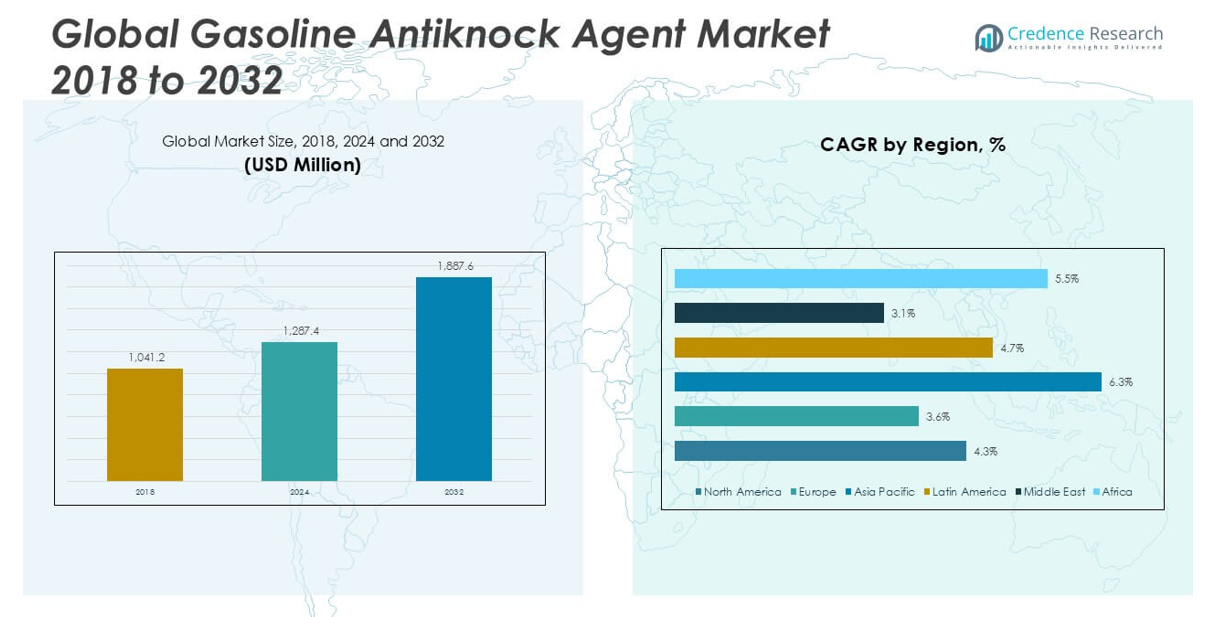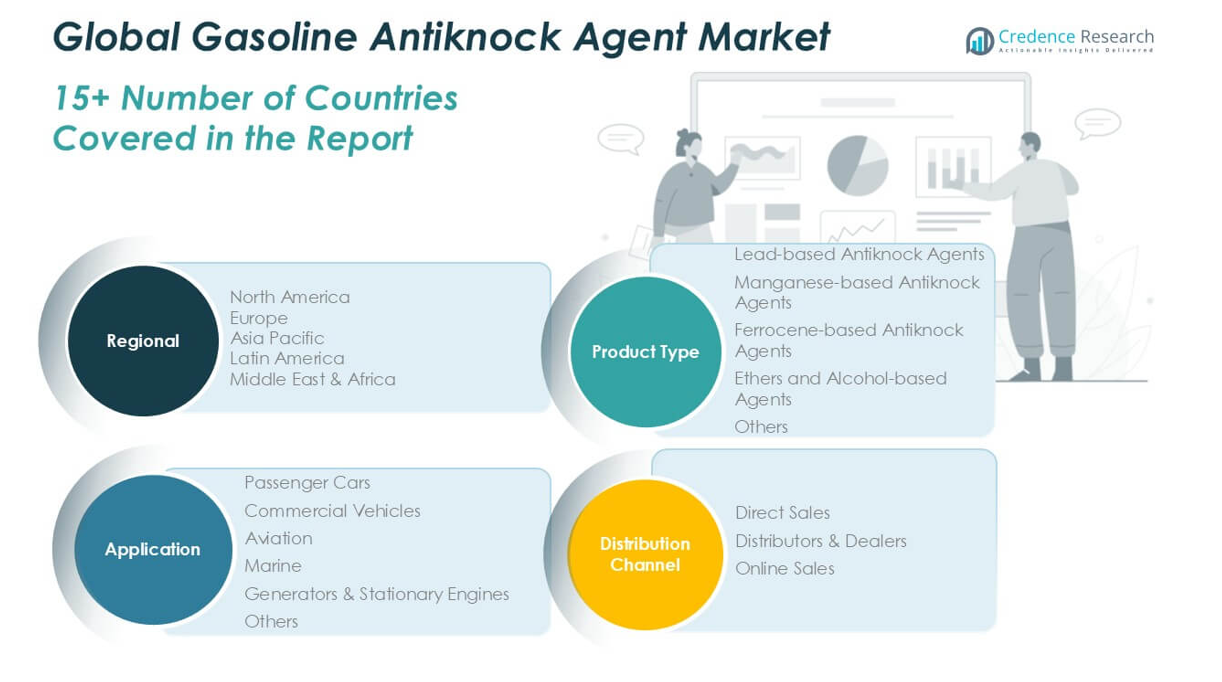CHAPTER NO. 1 : GENESIS OF THE MARKET
1.1 Market Prelude – Introduction & Scope
1.2 The Big Picture – Objectives & Vision
1.3 Strategic Edge – Unique Value Proposition
1.4 Stakeholder Compass – Key Beneficiaries
CHAPTER NO. 2 : EXECUTIVE LENS
2.1 Pulse of the Industry – Market Snapshot
2.2 Growth Arc – Revenue Projections (USD Million)
2.3. Premium Insights – Based on Primary Interviews
CHAPTER NO. 3 : GASOLINE ANTIKNOCK AGENT MARKET FORCES & INDUSTRY PULSE
3.1 Foundations of Change – Market Overview
3.2 Catalysts of Expansion – Key Market Drivers
3.2.1 Momentum Boosters – Growth Triggers
3.2.2 Innovation Fuel – Disruptive Technologies
3.3 Headwinds & Crosswinds – Market Restraints
3.3.1 Regulatory Tides – Compliance Challenges
3.3.2 Economic Frictions – Inflationary Pressures
3.4 Untapped Horizons – Growth Potential & Opportunities
3.5 Strategic Navigation – Industry Frameworks
3.5.1 Market Equilibrium – Porter’s Five Forces
3.5.2 Ecosystem Dynamics – Value Chain Analysis
3.5.3 Macro Forces – PESTEL Breakdown
3.6 Price Trend Analysis
3.6.1 Regional Price Trend
3.6.2 Price Trend by product
CHAPTER NO. 4 : KEY INVESTMENT EPICENTER
4.1 Regional Goldmines – High-Growth Geographies
4.2 Product Frontiers – Lucrative Product Categories
4.3 Application Sweet Spots – Emerging Demand Segments
CHAPTER NO. 5: REVENUE TRAJECTORY & WEALTH MAPPING
5.1 Momentum Metrics – Forecast & Growth Curves
5.2 Regional Revenue Footprint – Market Share Insights
5.3 Segmental Wealth Flow – Type & Application Revenue
CHAPTER NO. 6 : TRADE & COMMERCE ANALYSIS
6.1. Import Analysis by Region
6.1.1. Global Gasoline Antiknock Agent Market Import Volume By Region
6.2. Export Analysis by Region
6.2.1. Global Gasoline Antiknock Agent Market Export Volume By Region
CHAPTER NO. 7 : COMPETITION ANALYSIS
7.1. Company Market Share Analysis
7.1.1. Global Gasoline Antiknock Agent Market: Company Market Share
7.1. Global Gasoline Antiknock Agent Market Company Volume Market Share
7.2. Global Gasoline Antiknock Agent Market Company Revenue Market Share
7.3. Strategic Developments
7.3.1. Acquisitions & Mergers
7.3.2. New Product Launch
7.3.3. Regional Expansion
7.4. Competitive Dashboard
7.5. Company Assessment Metrics, 2024
CHAPTER NO. 8 : GASOLINE ANTIKNOCK AGENT MARKET – BY TYPE SEGMENT ANALYSIS
8.1. Gasoline Antiknock Agent Market Overview by Type Segment
8.1.1. Gasoline Antiknock Agent Market Volume Share By Type
8.1.2. Gasoline Antiknock Agent Market Revenue Share By Type
8.2. Lead-based Antiknock Agents
8.3. Manganese-based Antiknock Agents
8.4. Ferrocene-based Antiknock Agents
8.5. Ethers and Alcohol-based Agents
8.6. Others
CHAPTER NO. 9 : GASOLINE ANTIKNOCK AGENT MARKET – BY APPLICATION SEGMENT ANALYSIS
9.1. Gasoline Antiknock Agent Market Overview by Application Segment
9.1.1. Gasoline Antiknock Agent Market Volume Share By Application
9.1.2. Gasoline Antiknock Agent Market Revenue Share By Application
9.2. Passenger Cars
9.3. Commercial Vehicles
9.4. Aviation
9.5. Marine
9.6. Generators & Stationary Engines
9.7. Others
CHAPTER NO. 10 : GASOLINE ANTIKNOCK AGENT MARKET – BY DISTRIBUTION CHANNEL SEGMENT ANALYSIS
10.1. Gasoline Antiknock Agent Market Overview by Distribution Channel Segment
10.1.1. Gasoline Antiknock Agent Market Volume Share By Distribution Channel
10.1.2. Gasoline Antiknock Agent Market Revenue Share By Distribution Channel
10.2. Direct Sales
10.3. Distributors & Dealers
10.4. Online Sales
CHAPTER NO. 11 : GASOLINE ANTIKNOCK AGENT MARKET – REGIONAL ANALYSIS
11.1. Gasoline Antiknock Agent Market Overview by Region Segment
11.1.1. Global Gasoline Antiknock Agent Market Volume Share By Region
11.1.2. Global Gasoline Antiknock Agent Market Revenue Share By Region
11.1.3. Regions
11.1.4. Global Gasoline Antiknock Agent Market Volume By Region
11.1.5. Global Gasoline Antiknock Agent Market Revenue By Region
11.1.6. Type
11.1.7. Global Gasoline Antiknock Agent Market Volume By Type
11.1.8. Global Gasoline Antiknock Agent Market Revenue By Type
11.1.9. Application
11.1.10. Global Gasoline Antiknock Agent Market Volume By Application
11.1.11. Global Gasoline Antiknock Agent Market Revenue By Application
11.1.12. Distribution Channel
11.1.13. Global Gasoline Antiknock Agent Market Volume By Distribution Channel
11.1.14. Global Gasoline Antiknock Agent Market Revenue By Distribution Channel
CHAPTER NO. 12 : NORTH AMERICA GASOLINE ANTIKNOCK AGENT MARKET – COUNTRY ANALYSIS
12.1. North America Gasoline Antiknock Agent Market Overview by Country Segment
12.1.1. North America Gasoline Antiknock Agent Market Volume Share By Region
12.1.2. North America Gasoline Antiknock Agent Market Revenue Share By Region
12.2. North America
12.2.1. North America Gasoline Antiknock Agent Market Volume By Country
12.2.2. North America Gasoline Antiknock Agent Market Revenue By Country
12.2.3. Type
12.2.4. North America Gasoline Antiknock Agent Market Volume By Type
12.2.5. North America Gasoline Antiknock Agent Market Revenue By Type
12.2.6. Application
12.2.7. North America Gasoline Antiknock Agent Market Volume By Application
12.2.8. North America Gasoline Antiknock Agent Market Revenue By Application
12.2.9. Distribution Channel
12.2.10. North America Gasoline Antiknock Agent Market Volume By Distribution Channel
12.2.11. North America Gasoline Antiknock Agent Market Revenue By Distribution Channel
12.3. U.S.
12.4. Canada
12.5. Mexico
CHAPTER NO. 13 : EUROPE GASOLINE ANTIKNOCK AGENT MARKET – COUNTRY ANALYSIS
13.1. Europe Gasoline Antiknock Agent Market Overview by Country Segment
13.1.1. Europe Gasoline Antiknock Agent Market Volume Share By Region
13.1.2. Europe Gasoline Antiknock Agent Market Revenue Share By Region
13.2. Europe
13.2.1. Europe Gasoline Antiknock Agent Market Volume By Country
13.2.2. Europe Gasoline Antiknock Agent Market Revenue By Country
13.2.3. Type
13.2.4. Europe Gasoline Antiknock Agent Market Volume By Type
13.2.5. Europe Gasoline Antiknock Agent Market Revenue By Type
13.2.6. Application
13.2.7. Europe Gasoline Antiknock Agent Market Volume By Application
13.2.8. Europe Gasoline Antiknock Agent Market Revenue By Application
13.2.9. Distribution Channel
13.2.10. Europe Gasoline Antiknock Agent Market Volume By Distribution Channel
13.2.11. Europe Gasoline Antiknock Agent Market Revenue By Distribution Channel
13.3. UK
13.4. France
13.5. Germany
13.6. Italy
13.7. Spain
13.8. Russia
13.9. Rest of Europe
CHAPTER NO. 14 : ASIA PACIFIC GASOLINE ANTIKNOCK AGENT MARKET – COUNTRY ANALYSIS
14.1. Asia Pacific Gasoline Antiknock Agent Market Overview by Country Segment
14.1.1. Asia Pacific Gasoline Antiknock Agent Market Volume Share By Region
14.1.2. Asia Pacific Gasoline Antiknock Agent Market Revenue Share By Region
14.2. Asia Pacific
14.2.1. Asia Pacific Gasoline Antiknock Agent Market Volume By Country
14.2.2. Asia Pacific Gasoline Antiknock Agent Market Revenue By Country
14.2.3. Type
14.2.4. Asia Pacific Gasoline Antiknock Agent Market Volume By Type
14.2.5. Asia Pacific Gasoline Antiknock Agent Market Revenue By Type
14.2.6. Application
14.2.7. Asia Pacific Gasoline Antiknock Agent Market Volume By Application
14.2.8. Asia Pacific Gasoline Antiknock Agent Market Revenue By Application
14.2.9. Distribution Channel
14.2.10. Asia Pacific Gasoline Antiknock Agent Market Volume By Distribution Channel
14.2.11. Asia Pacific Gasoline Antiknock Agent Market Revenue By Distribution Channel
14.3. China
14.4. Japan
14.5. South Korea
14.6. India
14.7. Australia
14.8. Southeast Asia
14.9. Rest of Asia Pacific
CHAPTER NO. 15 : LATIN AMERICA GASOLINE ANTIKNOCK AGENT MARKET – COUNTRY ANALYSIS
15.1. Latin America Gasoline Antiknock Agent Market Overview by Country Segment
15.1.1. Latin America Gasoline Antiknock Agent Market Volume Share By Region
15.1.2. Latin America Gasoline Antiknock Agent Market Revenue Share By Region
15.2. Latin America
15.2.1. Latin America Gasoline Antiknock Agent Market Volume By Country
15.2.2. Latin America Gasoline Antiknock Agent Market Revenue By Country
15.2.3. Type
15.2.4. Latin America Gasoline Antiknock Agent Market Volume By Type
15.2.5. Latin America Gasoline Antiknock Agent Market Revenue By Type
15.2.6. Application
15.2.7. Latin America Gasoline Antiknock Agent Market Volume By Application
15.2.8. Latin America Gasoline Antiknock Agent Market Revenue By Application
15.2.9. Distribution Channel
15.2.10. Latin America Gasoline Antiknock Agent Market Volume By Distribution Channel
15.2.11. Latin America Gasoline Antiknock Agent Market Revenue By Distribution Channel
15.3. Brazil
15.4. Argentina
15.5. Rest of Latin America
CHAPTER NO. 16 : MIDDLE EAST GASOLINE ANTIKNOCK AGENT MARKET – COUNTRY ANALYSIS
16.1. Middle East Gasoline Antiknock Agent Market Overview by Country Segment
16.1.1. Middle East Gasoline Antiknock Agent Market Volume Share By Region
16.1.2. Middle East Gasoline Antiknock Agent Market Revenue Share By Region
16.2. Middle East
16.2.1. Middle East Gasoline Antiknock Agent Market Volume By Country
16.2.2. Middle East Gasoline Antiknock Agent Market Revenue By Country
16.2.3. Type
16.2.4. Middle East Gasoline Antiknock Agent Market Volume By Type
16.2.5. Middle East Gasoline Antiknock Agent Market Revenue By Type
16.2.6. Application
16.2.7. Middle East Gasoline Antiknock Agent Market Volume By Application
16.2.8. Middle East Gasoline Antiknock Agent Market Revenue By Application
16.2.9. Distribution Channel
16.2.10. Middle East Gasoline Antiknock Agent Market Volume By Distribution Channel
16.2.11. Middle East Gasoline Antiknock Agent Market Revenue By Distribution Channel
16.3. GCC Countries
16.4. Israel
16.5. Turkey
16.6. Rest of Middle East
CHAPTER NO. 17 : AFRICA GASOLINE ANTIKNOCK AGENT MARKET – COUNTRY ANALYSIS
17.1. Africa Gasoline Antiknock Agent Market Overview by Country Segment
17.1.1. Africa Gasoline Antiknock Agent Market Volume Share By Region
17.1.2. Africa Gasoline Antiknock Agent Market Revenue Share By Region
17.2. Africa
17.2.1. Africa Gasoline Antiknock Agent Market Volume By Country
17.2.2. Africa Gasoline Antiknock Agent Market Revenue By Country
17.2.3. Type
17.2.4. Africa Gasoline Antiknock Agent Market Volume By Type
17.2.5. Africa Gasoline Antiknock Agent Market Revenue By Type
17.2.6. Application
17.2.7. Africa Gasoline Antiknock Agent Market Volume By Application
17.2.8. Africa Gasoline Antiknock Agent Market Revenue By Application
17.2.9. Distribution Channel
17.2.10. Africa Gasoline Antiknock Agent Market Volume By Distribution Channel
17.2.11. Africa Gasoline Antiknock Agent Market Revenue By Distribution Channel
17.3. South Africa
17.4. Egypt
17.5. Rest of Africa
CHAPTER NO. 18 : COMPANY PROFILES
18.1. Afton Chemical Corporation
18.1.1. Company Overview
18.1.2. Product Portfolio
18.1.3. Financial Overview
18.1.4. Recent Developments
18.1.5. Growth Strategy
18.1.6. SWOT Analysis
18.2. BASF SE
18.3. Chevron Oronite Company LLC
18.4. Innospec Inc.
18.5. The Lubrizol Corporation
18.6. TotalEnergies SE
18.7. Evonik Industries AG
18.8. Infineum International Limited
18.9. Dorf Ketal Chemicals India Pvt Ltd
18.10. Baker Hughes
18.11. LANXESS AG
18.12. Clariant AG
18.13. Croda International Plc
18.14. Shandong Dongchang Fine Chemical Technology









